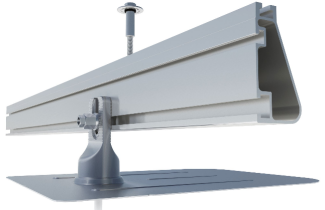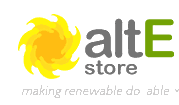
A solar panel roof mount (also called a solar racking mount or solar system mount) will hold your solar panels and system in place. The mounting system is a crucial component because it is responsible for securing and stabilizing the solar panels on your roof without compromising the roof’s stability or water tightness.
You want to be completely confident that you have selected a mounting system that can stand up to harsh weather and other factors. Your roof mount is one of the most important ways to protect your investment in solar energy.
The Rundown on Solar Racking: Everything You Need to Know
Solar racking is an essential part of any solar energy system. It is the system that holds the solar panels in place on your roof and ensures they are secure and stable. If you’re considering installing a solar energy system for your home, it’s important to understand the basics of solar racking and how it works. In this blog post, we’ll provide you with an overview of what solar racking is and the different types of solar racking systems available. We’ll also discuss how to choose the best system for your needs.
What is Solar Racking?
Solar racking, also known as PV racking, is the process of mounting solar panels to a structure. This can be a roof, a ground-mounted system or even a pole mount. Solar racking involves choosing and installing the components and systems needed to support and secure your solar array. The type of racking system you need will vary depending on the size and design of your solar array and the installation location. Solar racking systems are designed to withstand different environmental conditions, including wind, rain and snow. They must also provide an adequate amount of support and stability to ensure your solar array remains in place.
Types of Solar Racking:
- Roof Mounting
- Ground Mounting
- Side of Pole Mounting
- Top of Pole Mounting
When it comes to solar racking systems, there are several different types available depending on your needs. The two most popular types of racking for photovoltaic (PV) systems are ground and roof mounts. Ground mounts are typically used in large-scale solar projects and can be used with tilt angles that range from 0 to 40 degrees. The angle is important as it will determine the amount of sunlight your solar panels will receive over the course of a year. Additionally, ground mounts provide a solid foundation for your solar system since they are not connected to a roof structure. This makes them better suited for areas with high wind speeds or seismic activity.
Roof mounts are the most common type of PV racking and can be mounted directly onto your roof or onto an independent racking structure. Depending on the roof type and size, different mounting systems may need to be used, such as clamping, ballasting, and rail systems. In addition, roof mount systems can also be adjusted to accommodate different roof pitches and tilt angles, which helps maximize the performance of your solar system.
Which Solar Panel Roof Mount Solutions are Best?
altE offers the following high quality solar panel mounting and racking solutions from top brands:
IronRidge Roof Mounting System
IronRidge is well known for its XR Rails, which are used for their roof mounting systems and ground mounting systems as well. IronRidge offers an easy-to-use Design Assistant tool to help you list out which parts you need for your racking system.
For their roof mounting system, you will need to:
1) Choose your XR Rail:
XR10 Rail 
Select Clear: 14', 17'
- Low-profile rail- no snow areas
- Up to 6' spanning capability
- Light/Moderate load capability
XR100 Rail 
Select Clear: 11', 14', 17'
Select Black: 11', 14', 17'
- Std. residential mounting rail
- Up to 8' spanning capability
- Heavy load capability
XR1000 Rail 
Select Clear: 11', 14', 17'
- Heavyweight mounting rail
- Up to 12' spanning capability
- Extreme load capability
Need Splices? 
Select: XR10, XR100, XR1000
- Use internal splices for a seamless, bonded connection that extends rail length
And Endcaps? 
Select: XR10, XR100, XR1000
- Endcaps provide a finished look to rails, while protecting the collection of water and debris inside the rail
2) Choose the appropriate Clamps & Grounding:
Midclamps 
Select: Clear, Black
- Universal Fastening Object UFO
- Bonds the modules to the rails
Endclamps 
Shop: Stopper Sleeves or CAMO
- Stoppers snap onto a UFO
- Turns into a bonded endclamp
- Sized to module frame width
- NEW- CAMO Universal Endclamp fits all modules
Grounding 
Shop: Lugs and Straps
- Only one grounding lug per row
- Microinverter bonding kit
- Grounding strap for rows over 50ft
3) Lastly, don't forget your Attachments:
Flashing 
Select: Mill, Black
- FlashVue - superior waterproofing
- Conduit Mount for flashing conduit, strut, or junction boxes
- Bonding hardware sold separately
Slotted L-Feet 
Select: Mill, Black
- Drop-in design for rapid and secure rail attachment
- Bonding hardware sold separately
Tamarack Flush Roof Mount System Kits
Tamarack Solar offers economical and robust mounting kits that are UPS-able. They also produce ground mounts, top-of-pole mounts, and side-of-pole mounts. Their roof mount kits consist of:
- All the parts needed for a 4- or 8-panel roof mount installation - all in one UPS-able kit
- Easy wire management where all system wiring fits inside the rails
- Universal clamps that fit a variety of solar panel frame thicknesses, from 30mm to 40mm
- Different kit versions for light to heavy snow/wind loads
Solar Stack Adhesive Roof Mount System
Check out the rail-less and roof penetration-free flush and tilt mount option from Solar Stack that uses a polyurethane foam that adheres to both a huge variety of roof types and the strictest building codes in North America. This mounting system is ideal in wet climates and is rated to withstand conditions even in High Velocity Hurricane Zone (HVHZs) such as South Florida and Puerto Rico.
- No roof penetrations
- No rails needed - panels attach directly to mounts
- No mechanical attachments or ballast systems needed
- Simply prime, spray foam, and place mounts
- Use 12" mounts in coastal areas and other wind zones













